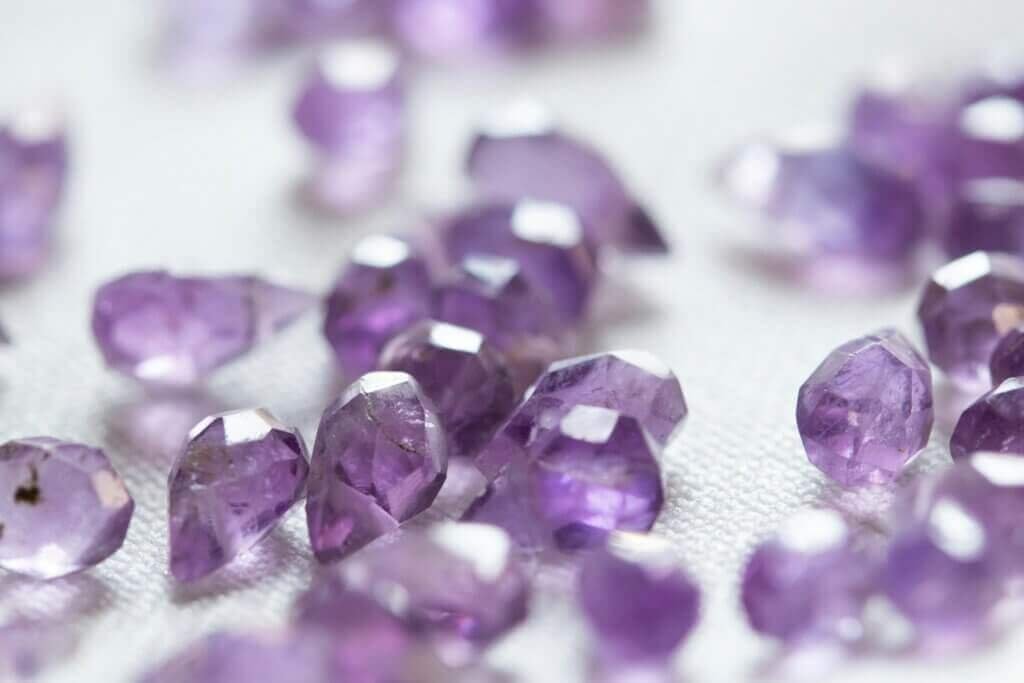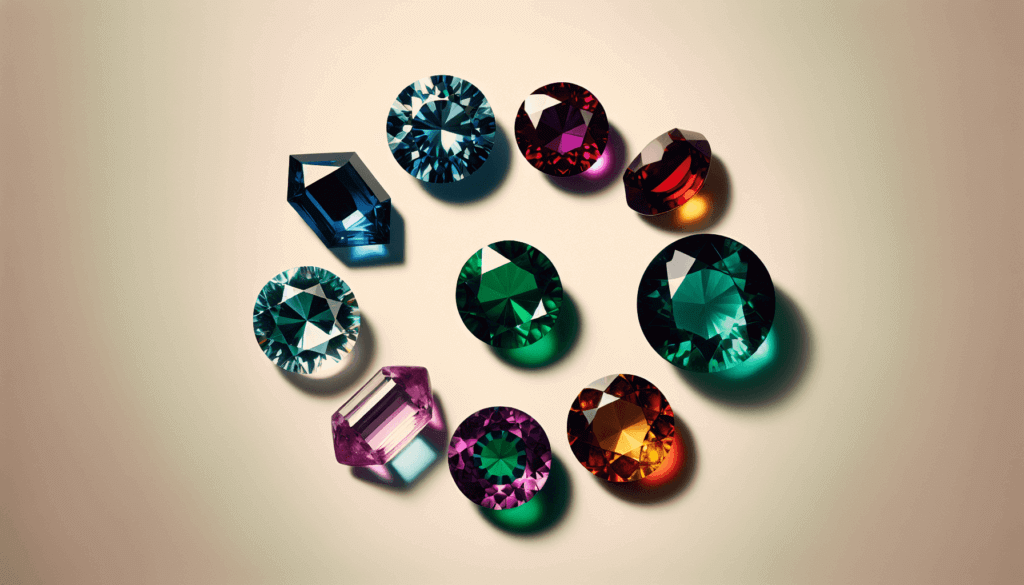You’re about to embark on a sparkling journey into the enchanting world of gemstones. “What Are The 7 Precious Stones And Gems?” will be your guide as we illuminate the beauty and significance of these dazzling jewels. We’ll reveal the unique characteristics that make each stone priceless, and discuss the intriguing lore and history that’s been associated with them throughout time. So polish up your curiosity and get ready to explore the stunning allure of the seven treasured gems that have fascinated people for centuries. Let’s shine a light on these remarkable stones!

1. Diamond
Origins and History
You may be surprised to know that the sparkling diamonds you see today were originally just pieces of carbon subjected to extreme heat and pressure over billions of years beneath the Earth’s crust. The first recorded history of diamond mining dates back to 4th century BC in India. They were adored because of their ability to refract light and were used as religious icons, intricate engraving tools, and, of course, decorative items.
Physical Characteristics and Properties
What makes diamonds special are their physical characteristics. Diamonds are renowned for their hardness, scoring a perfect 10 on the Mohs scale. This durability, combined with their exceptional luster and high refractive index make them desirable and well-suited for ornamentation. Naturally, diamonds are transparent with a high dispersion of light, but they can also exhibit various colors depending on the presence of impurities.
Symbolism and Cultural Significance
Throughout history, diamonds have held a deep cultural significance and symbolism. They’re often associated with eternal love and durability, which is why they’re the gem of choice for engagement and wedding rings. Diamonds also symbolize wealth, power, and strength owing to their resilience and brilliance.
Famous Diamonds
There are many famous diamonds that have captivated the world. The largest diamond ever discovered is the Cullinan Diamond, a staggering 3106 carats gem. Then there’s the enigmatic Hope Diamond, known for its deep-blue color and purported curse.
2. Ruby
Origins and History
Rubies, known as “king of precious stones,” originate from the mineral family corundum. They have been treasured for thousands of years, dating back to the time of the ancient Greeks. Notably, majority of the world’s rubies came from Myanmar (formerly Burma), even though they can also be found in other parts of the world.
Physical Characteristics and Properties
Rubies are distinguished by their rich, red color which can range from purplish and bluish red to orangey-red. They rank 9 on the Mohs scale, second only to diamonds, making them very resistant to scratches and wear. Rubies are also known for their luster and rarity.
Symbolism and Cultural Significance
In various cultures, rubies have been synonymous with power, protection, and passion. They’re also associated often with love and vitality. Ancient warriors would embed rubies into their skin to grant invulnerability, while others considered them a talisman against disaster.
Famous Rubies
The Sunrise Ruby is the world’s most expensive ruby, sold at a staggering $30 million. On the other hand, the Rosser Reeves Star Ruby is known for its distinct star pattern.

3. Emerald
Origins and History
Emeralds, part of the beryl family, have been admired since ancient times. They were first discovered in Egypt, dating back to 330 BC. Today, Colombia is the world’s largest producer of emeralds.
Physical Characteristics and Properties
Emeralds are known for their enchanting green hue, ranging from light green to a deep, rich green. The color is due to trace amounts of chromium and vanadium. While not as hard as diamonds or rubies, scoring 7.5-8 on the Mohs scale, they’re still remarkably durable.
Symbolism and Cultural Significance
Emeralds have been associated with fertility, rebirth, and love. Ancient Romans dedicated this stone to Venus, the goddess of love and beauty. Nowadays, they’re often gifted to celebrate significant anniversaries.
Famous Emeralds
The Bahia Emerald, found in Brazil, is notoriously famous due to legal disputes surrounding its ownership. Meanwhile, the famous Hooker Emerald Brooch, once owned by Abdul Hamid II, the Ottoman Empire Sultan, is now a part of the Smithsonian collection.
4. Sapphire
Origins and History
Like rubies, sapphires are also part of the corundum family. Their history traces back to ancient Persia, where it was believed the sky was painted blue by the reflection of sapphires. Today, these gemstones are primarily sourced from Sri Lanka, Madagascar, and Myanmar.
Physical Characteristics and Properties
Although popularly known for their royal blue color, sapphires come in a plethora of other hues, except red. They share the same Mohs scale rating as rubies (9), signifying their superb strength.
Symbolism and Cultural Significance
Sapphires are symbolic of nobility, truth, and faithfulness, which is why they’re popular in engagement rings. They were believed to bring protection and prophetic wisdom, hence often worn by medieval kings.
Famous Sapphires
Few sapphires have claimed fame, such as the Star of India, the largest and most famous star sapphire, and the Logan Sapphire, one of the largest faceted blue sapphires in existence.

5. Opal
Origins and History
Opals are formed from a solution of silicon dioxide and water. Australia leads in production, providing over 90% of the world’s supply.
Physical Characteristics and Properties
Opals are loved for their play-of-color, a unique property where flashes of different colors are visible from different angles. They range from 5.5-6.5 on the Mohs scale, which is relatively soft.
Symbolism and Cultural Significance
Opals symbolize faithfulness, confidence, and creativity due to their changing colors. Fortune-tellers used opals as a magical tool to invoke visions.
Famous Opals
The “Olympic Australis” is the largest and most valuable opal in existence, while the “Fire of Australia” is recognized for its remarkable quality and color.
6. Amethyst
Origins and History
Amethyst, a type of quartz, was esteemed as precious as ruby and emerald in the past. The ideal grade amethyst is called “Deep Siberian”, and has a primary purple hue of around 75-80%.
Physical Characteristics and Properties
Amethysts are easily recognizable by their beautiful violet color. They score a 7 on the Mohs scale, a relatively good toughness.
Symbolism and Cultural Significance
Amethysts symbolize peace, courage, and stability. They’re often used in meditation for their calming energies.
Famous Amethysts
The largest amethyst geode, the “Empress of Uruguay”, resides in Australia while the Smithsonian institution houses the world’s largest faceted amethyst, the “Marjorie Merriweather Post’s Amethyst”.

7. Pearl
Origins and History
Unlike most gems that are mined from Earth, pearls are formed within oysters, mussels, and other shellfish. Cultured or farmed pearls have become common since the early 1900s.
Physical Characteristics and Properties
Pearls are known for their lustrous, iridescent sheen and smooth surface. They’re relatively soft, scoring only 2.5-3 on the Mohs scale.
Symbolism and Cultural Significance
Pearls symbolize wisdom, purity, and integrity. They’re often worn by brides as a sign of innocence and beauty.
Famous Pearls
Some famous pearls include La Peregrina Pearl, famously worn by Elizabeth Taylor, and the Pearl of Allah or Pearl of Lao Tzu, known as the largest pearl ever discovered.
8. Proper Care and Maintenance for Precious Stones and Gems
Regular Cleaning
Proper cleaning is crucial to maintain the sparkle of your precious gems. Use a soft, lint-free cloth or a soft brush with warm water and mild soap.
Storage and Handling
Always store your gems individually to avoid scratches. Avoid direct sunlight and high temperatures. Also, put on your jewelry last to avoid contact with cosmetics.
Professional Maintenance and Restoration
Consult with a professional jeweler annually for maintenance checks regarding any loose settings or damaged gemstones.

9. Factors Affecting Value of Precious Stones and Gems
Size and Weight
With most gemstones, larger sizes significantly increase the value due to their rare occurrence in nature.
Color and Clarity
The color should be vibrant and pure, while clarity refers to the absence of inclusions or blemishes.
Cut and Shape
A well-cut gemstone maximizes its color and minimizes inclusions, enhancing overall aesthetics and increasing value.
Market Demand
Finally, the value is heavily influenced by market demand. Stones that are popular in the market tend to fetch higher prices.
10. Usage of Precious Stones and Gems in Jewelry
Engagement and Wedding Rings
Diamonds are the preferred choice for these symbols of eternal love, with sapphires and rubies also gaining popularity.
Necklaces and Pendants
Emeralds, pearls, and opals are often used in necklaces and pendants for their striking colors and unique visual effects.
Bracelets and Bangles
Rubies, sapphires, and amethysts are frequently used in bracelets and bangles for their sturdiness and vibrant colors.
Earrings and Brooches
All precious stones and gems are utilized in earrings and brooches providing variety to anyone’s personal style.



